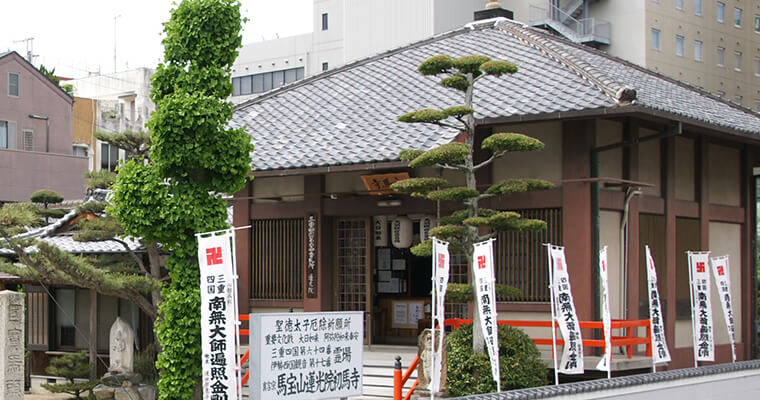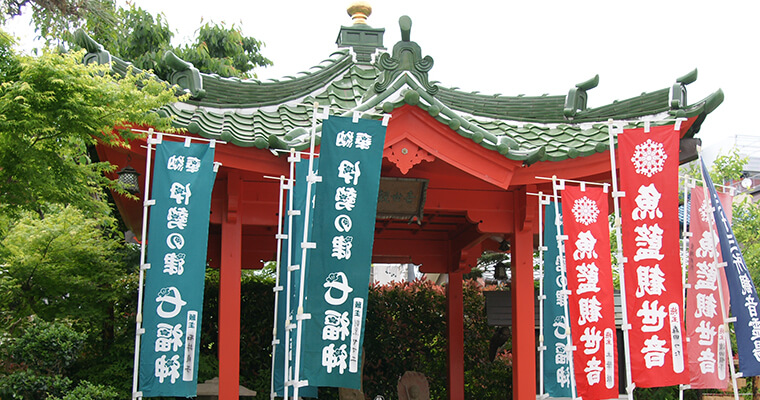Number 17Renkō-in Hatsuuma-dera temple
History of the temple
According to the legend a famous politician and promoter of Buddhism – Prince Shōtoku (574-622) visited this area to construct the Shitennō-ji temple. On his way the 42 years old Prince became sick. At the same time he received news from the Capital that his Mother, the Empress, was also indisposed. Moreover, the construction of temple’s buildings did not go as planned. Troubled Prince asked his teacher Eiji for advice. Eiji instructed him to carve a statue of Batō Kannon (Horse-Headed Kannon). Next Eiji carved a statue of Dainichi Nyorai (Great Illuminating Buddha) by himself and asked another monk Esō to carve a statue of Buddha Amida (Buddha of Infinite Light). Then Prince Shōtoku built a temple in the north-east direction (kimon – unlucky direction) of the Shitennō-ji and enshrined all three statues inside. He invited virtues Buddhist high priests from Hōkō-ji temple in Asuka and conducted a bad fortune expelling ritual. The ritual was a success and the Prince, as well as his family, recovered from illness. The construction of the Shitennō-ji also progressed and was completed according to the plan. The ritual was conducted on the 1st day of the horse in the year 618.
This was the beginning for the Renkō-in Hatsuuma-dera temple. It also explains the origins of the Main Statue of Batō Kannon and the sitting statues of Dainichi Nyorai and Buddha Amida (both of them registered as National Important Cultural Property). At the time of the temple’s construction it belonged to Hossō sect but since 1242 it belongs to Shingon.
Until 17th Century Renkō-in Hatsuuma-dera was a practice hall which prayed for spiritual protection of the state, but since 1617 it became a temple which prayed for the Tōdō clan. The 2nd daimyo of this province Tōdō Takatsugu (1602-1676) founded new buildings for the temple. The construction at the current site was finished in 1672 and since then Renkō-in Hatsuuma-dera became a temple praying for expelling of bad luck of Tōdō clan. In 1680 the 3rd daimyo Tōdō Takahisa (1638-1703) donated a sign with the temple’s name Hatsuuma-dera. Since then the temple became popular as Kannon who expels bad luck.
Unfortunately in the 2nd World War, during the air raid on Tsu in 1945, this old temple was bombed and destroyed. In 1952 and 1955 Buddhist statues which are National Treasure were repaired. In the same year the Hōanko (a building with Emperor’s photograph) was rebuild. The Main Hall, which stands to this day, was reconstructed in 1976. Renkō-in Hatsuuma-dera still stands close to the Shitennō-ji. The link of these two temples is an existing proof of the history of the area.
This temple is known as Shōtoku Taishi Yakuyoke Kigansho Hatsuuma-dera (Temple which is a praying ground where Prince Shōtoku prayed to get his bad luck expelled). Every year in March on the 1st day of the Horse many worshipers gather to pray at the temple.

Outline
-
Honorific name
Bahōzan
-
Temple's name
Hatsuuma-dera
-
Sect
Shingon Omuro branch
-
Religious service
Batō Kannon
(Horse-Headed Kannon)

Details
-
Address
Mie Prefecture Tsu Sakaemachi 3-210
-
Phone number
059-227-3632
-
Stamp place
Temple's counter
-
Opening hours
8:00 - 17:00
-
Official website




